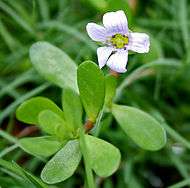Bacopa monnieri
Bacopa monnieri is a perennial, creeping herb native to the wetlands of southern and Eastern India, Australia, Europe, Africa, Asia, and North and South America.[2] It is known by the common names water hyssop,[1] waterhyssop, brahmi,[2] thyme-leafed gratiola, herb of grace,[2] and Indian pennywort.[2]
| Bacopa monnieri | |
|---|---|
 | |
| Scientific classification | |
| Kingdom: | Plantae |
| Clade: | Tracheophytes |
| Clade: | Angiosperms |
| Clade: | Eudicots |
| Clade: | Asterids |
| Order: | Lamiales |
| Family: | Plantaginaceae |
| Genus: | Bacopa |
| Species: | B. monnieri |
| Binomial name | |
| Bacopa monnieri | |
| Synonyms | |
|
Bacopa monniera Hayata & Matsum. | |
Bacopa monnieri is used in Ayurveda. In 2019, the US Food and Drug Administration (FDA) warned manufacturers of dietary supplement products containing Bacopa monnieri against making illegal and unproven claims that the herb can treat various diseases.[3][4][5]
Description

Bacopa monnieri is a non-aromatic herb. The leaves of this plant are succulent, oblong, and 4–6 mm (0.16–0.24 in) thick. Leaves are oblanceolate and are arranged oppositely on the stem. The flowers are small, actinomorphic and white, with four to five petals. It can even grow in slightly brackish conditions. Propagation is often achieved through cuttings.[6]
Ecology
Bacopa monnieri is one of the most widespread Bacopa species. It commonly grows in marshy areas throughout India, Nepal, Sri Lanka, China, Pakistan, Taiwan, Vietnam, tropical and southern Africa, on Madagascar, in Australia, in the Caribbean as well as in Middle and South America.[2] It is also found in Florida, Texas, and Hawaii.[1]
Uses
Consumption
Bacopa monnieri is used in Ayurvedic traditional medicine to improve memory and to treat various ailments.[7] Preliminary clinical research found that Bacopa monnieri may improve cognition.[7][8][9]
Adverse effects
The most commonly reported adverse effects of Bacopa monnieri in humans are nausea, increased intestinal motility, and gastrointestinal upset.[7]
Illegal marketing claims
In 2019, the FDA issued warning letters to manufacturers of dietary supplements containing Bacopa monnieri that advertised health claims for treating or preventing stomach disease, Alzheimer's disease, hypoglycemia, blood pressure, and anxiety were unproven and illegal. The FDA stated that Bacopa monnieri products have not been approved for these or any medical purposes.[3][4][5]
Ornamental
Its ability to grow in water makes it a popular aquarium plant.
Phytochemistry
The best characterized phytochemicals in Bacopa monnieri are dammarane-type triterpenoid saponins known as bacosides, with jujubogenin or pseudo-jujubogenin moieties as aglycone units.[10] Bacosides comprise a family of 12 known analogs.[11] Other saponins called bacopasides I–XII were identified.[12] The alkaloids brahmine, nicotine, and herpestine have been catalogued, along with D-mannitol, apigenin, hersaponin, monnierasides I–III, cucurbitacin and plantainoside B.[13][14][15]
References
- Lansdown, R.V.; Knees, S.G.; Patzelt, A. (2013). "Bacopa monnieri". IUCN Red List of Threatened Species. 2013: e.T164168A17722668. doi:10.2305/IUCN.UK.2013-1.RLTS.T164168A17722668.en. Retrieved 10 January 2020.
- "Bacopa monnieri". Germplasm Resources Information Network (GRIN). Agricultural Research Service (ARS), United States Department of Agriculture (USDA). Retrieved 2008-03-13.
- "Health fraud scams: Unproven Alzheimer's disease products (Bacopa monnieri listed)". US Food and Drug Administration. 22 December 2018. Retrieved 11 May 2019.
- William A Correll, Jr. (5 February 2019). "FDA Warning Letter: Peak Nootropics LLC aka Advanced Nootropics". Office of Compliance, Center for Food Safety and Applied Nutrition, Inspections, Compliance, Enforcement, and Criminal Investigations, US Food and Drug Administration. Retrieved 11 May 2019.
- William A Correll, Jr. (5 February 2019). "FDA Warning Letter: TEK Naturals". Office of Compliance, Center for Food Safety and Applied Nutrition, Inspections, Compliance, Enforcement, and Criminal Investigations, US Food and Drug Administration. Retrieved 11 May 2019.
- Oudhia, Pankaj (2004). "Bramhi (Bacopa monnieri)". Society for Parthenium Management (SOPAM). Retrieved July 30, 2017.
- Aguiar, Sebastian; Borowski, Thomas (2013). "Neuropharmacological review of the nootropic herb Bacopa monnieri". Rejuvenation Research. 16 (4): 313–326. doi:10.1089/rej.2013.1431. ISSN 1557-8577. PMC 3746283. PMID 23772955.
- Kongkeaw, C; Dilokthornsakul, P; Thanarangsarit, P; Limpeanchob, N; Norman Scholfield, C (2014). "Meta-analysis of randomized controlled trials on cognitive effects of Bacopa monnieri extract". Journal of Ethnopharmacology. 151 (1): 528–35. doi:10.1016/j.jep.2013.11.008. PMID 24252493.
- Neale, Chris; Camfield, David; Reay, Jonathon; Stough, Con; Scholey, Andrew (5 February 2013). "Cognitive effects of two nutraceuticals Ginseng and Bacopa benchmarked against modafinil: a review and comparison of effect sizes". British Journal of Clinical Pharmacology. 75 (3): 728–737. doi:10.1111/bcp.12002. ISSN 0306-5251. PMC 3575939. PMID 23043278.
- Sivaramakrishna, C; Rao, CV; Trimurtulu, G; Vanisree, M; Subbaraju, GV (2005). "Triterpenoid glycosides from Bacopa monnieri". Phytochemistry. 66 (23): 2719–2728. doi:10.1016/j.phytochem.2005.09.016. PMID 16293276.
- Garai, S; Mahato, SB; Ohtani, K; Yamasaki, K (2009). "Dammarane triterpenoid saponins from Bacopa monnieri". Can J Chem. 87 (9): 1230–1234. doi:10.1139/V09-111.
- Chakravarty, A.K; Garai, S.; Masuda, K; Nakane, T; Kawahara, N. (2003). "Bacopasides III–V: Three new triterpenoid glycosides from Bacopa monnieri". Chem Pharm Bull. 51 (2): 215–217. doi:10.1248/cpb.51.215. PMID 12576661.
- Chatterji, N; Rastogi, RP; Dhar, ML (1965). "Chemical examination of Bacopa monniera Wettst: Part II—Isolation of chemical constituents". Ind J Chem. 3: 24–29.
- Chakravarty, AK; Sarkar, T; Nakane, T; Kawahara, N; Masuda, K (2008). "New phenylethanoid glycosides from Bacopa monnieri". Chem Pharm Bull. 50 (12): 1616–1618. doi:10.1248/cpb.50.1616. PMID 12499603.
- Bhandari, Pamita; Kumar, Neeraj; Singh, Bikram; Kaul, Vijay K. (2007). "Cucurbitacins from Bacopa monnieri". Phytochemistry. 68 (9): 1248–1254. doi:10.1016/j.phytochem.2007.03.013. ISSN 0031-9422.
External links
| Wikimedia Commons has media related to Bacopa monnieri. |
